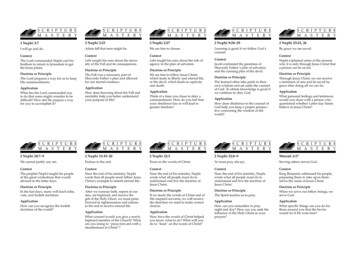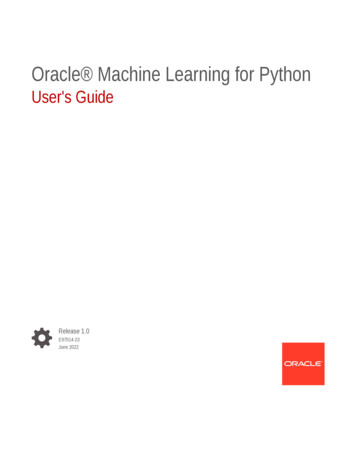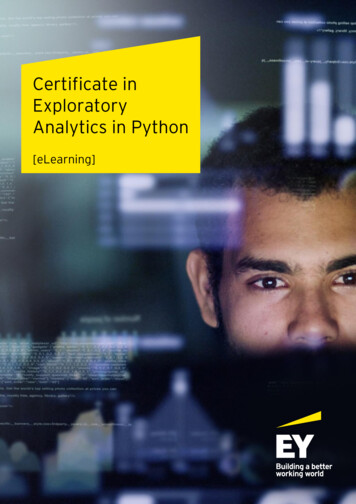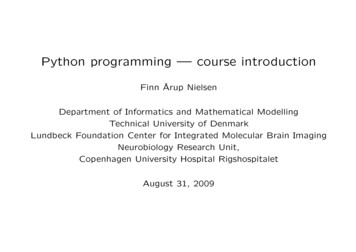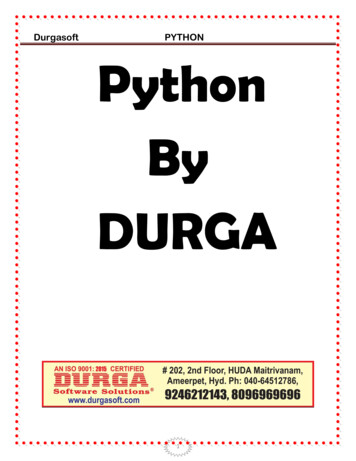
Transcription
Machine learning mastery with python jason pdf book pdf free
Machine learning mastery with python jason pdf book pdf free1 2 Jason Brownlee Machine Learning Mastery With Python Understand Your Data, Create Accurate Models and Work Projects End-To-End3 i Machine Learning Mastery With Python Copyright 2016 Jason Brownlee. All Rights Reserved. Edition: v1.44 Contents Preface iii I Introduction 1 1 Welcome Learn Python Machine Learning The Wrong WayMachine Learning in Python What This Book is Not Summary II Lessons 8 2 Python Ecosystem for Machine Learning Python SciPy scikit-learn Python Ecosystem Installation Summary Crash Course in Python and SciPy Python Crash Course NumPy Crash Course Matplotlib Crash Course Pandas Crash Course Summary How To Load Machine LearningData Considerations When Loading CSV Data Pima Indians Dataset Load CSV Files with the Python Standard Library Load CSV Files with NumPy Load CSV Files with Pandas Summary ii5 5 Understand Your Data With Descriptive Statistics Peek at Your Data Dimensions of Your Data Data Type For Each Attribute Descriptive Statistics ClassDistribution (Classification Only) Correlations Between Attributes Skew of Univariate Distributions Tips To Remember Summary Understand Your Data With Visualization Univariate Plots Multivariate Plots Summary Prepare Your Data For Machine Learning Need For Data Pre-processing Data Transforms Rescale Data Standardize Data NormalizeData Binarize Data (Make Binary) Summary Feature Selection For Machine Learning Feature Selection Univariate Selection Recursive Feature Elimination Principal Component Analysis Feature Importance Summary Evaluate the Performance of Machine Learning Algorithms with Resampling Evaluate Machine Learning Algorithms Split into Trainand Test Sets K-fold Cross Validation Leave One Out Cross Validation Repeated Random Test-Train Splits What Techniques to Use When Summary Machine Learning Algorithm Performance Metrics Algorithm Evaluation Metrics Classification Metrics Regression Metrics Summary iii6 11 Spot-Check Classification Algorithms Algorithm Spot-CheckingAlgorithms Overview Linear Machine Learning Algorithms Nonlinear Machine Learning Algorithms Summary Spot-Check Regression Algorithms Algorithms Overview Linear Machine Learning Algorithms Nonlinear Machine Learning Algorithms Summary Compare Machine Learning Algorithms Choose The Best Machine Learning Model CompareMachine Learning Algorithms Consistently Summary Automate Machine Learning Workflows with Pipelines Automating Machine Learning Workflows Data Preparation and Modeling Pipeline Feature Extraction and Modeling Pipeline Summary Improve Performance with Ensembles Combine Models Into Ensemble Predictions Bagging AlgorithmsBoosting Algorithms Voting Ensemble Summary Improve Performance with Algorithm Tuning Machine Learning Algorithm Parameters Grid Search Parameter Tuning Random Search Parameter Tuning Summary Save and Load Machine Learning Models Finalize Your Model with pickle Finalize Your Model with Joblib Tips for Finalizing Your ModelSummary iv III Projects Predictive Modeling Project Template Practice Machine Learning With Projects7 18.2 Machine Learning Project Template in Python Machine Learning Project Template Steps Tips For Using The Template Well Summary Your First Machine Learning Project in Python Step-By-Step The Hello World of Machine Learning LoadThe Data Summarize the Dataset Data Visualization Evaluate Some Algorithms Make Predictions Summary Regression Machine Learning Case Study Project Problem Definition Load the Dataset Analyze Data Data Visualizations Validation Dataset Evaluate Algorithms: Baseline Evaluate Algorithms: Standardization Improve Results With TuningEnsemble Methods Tune Ensemble Methods Finalize Model Summary Binary Classification Machine Learning Case Study Project Problem Definition Load the Dataset Analyze Data Validation Dataset Evaluate Algorithms: Baseline Evaluate Algorithms: Standardize Data Algorithm Tuning Ensemble Methods Finalize Model Summary More PredictiveModeling Projects Build And Maintain Recipes Small Projects on Small Datasets Competitive Machine Learning Summary v8 IV Conclusions How Far You Have Come Getting More Help General Advice Help With Python Help With SciPy and NumPy Help With Matplotlib Help With Pandas Help With scikit-learn vi9 Preface I think Python is an amazingplatform for machine learning. There are so many algorithms and so much power ready to use. I am often asked the question: How do you use Python for machine learning? This book is my definitive answer to that question. It contains my very best knowledge and ideas on how to work through predictive modeling machine learning projects using thePython ecosystem. It is the book that I am also going to use as a refresher at the start of a new project. I m really proud of this book and I hope that you find it a useful companion on your machine learning journey with Python. Jason Brownlee Melbourne, Australia 2016 vii10 Part I Introduction 111 Chapter 1 Welcome Welcome to Machine LearningMastery With Python. This book is your guide to applied machine learning with Python. You will discover the step-by-step process that you can use to get started and become good at machine learning for predictive modeling with the Python ecosystem. 1.1 Learn Python Machine Learning The Wrong Way Here is what you should NOT do when youstart studying machine learning in Python. 1. Get really good at Python programming and Python syntax. 2. Deeply study the underlying theory and parameters for machine learning algorithms in scikit-learn. 3. Avoid or lightly touch on all of the other tasks needed to complete a real project. I think that this approach can work for some people, but it isa really slow and a roundabout way of getting to your goal. It teaches you that you need to spend all your time learning how to use individual machine learning algorithms. It also does not teach you the process of building predictive machine learning models in Python that you can actually use to make predictions. Sadly, this is the approach used toteach machine learning that I see in almost all books and online courses on the topic. 1.2 Machine Learning in Python This book focuses on a specific sub-field of machine learning called predictive modeling. This is the field of machine learning that is the most useful in industry and the type of machine learning that the scikit-learn library in Pythonexcels at facilitating. Unlike statistics, where models are used to understand data, predictive modeling is laser focused on developing models that make the most accurate predictions at the expense of explaining why predictions are made. Unlike the broader field of machine learning that could feasibly be used with data in any format, predictivemodeling is primarily focused on tabular data (e.g. tables of numbers like in a spreadsheet). This book was written around three themes designed to get you started and using Python for applied machine learning effectively and quickly. These three parts are as follows: 212 1.2. Machine Learning in Python 3 Lessons : Learn how the sub-tasks of amachine learning project map onto Python and the best practice way of working through each task. Projects : Tie together all of the knowledge from the lessons by working through case study predictive modeling problems. Recipes : Apply machine learning with a catalog of standalone recipes in Python that you can copy-and-paste as a starting pointfor new projects Lessons You need to know how to complete the specific subtasks of a machine learning project using the Python ecosystem. Once you know how to complete a discrete task using the platform and get a result reliably, you can do it again and again on project after project. Let s start with an overview of the common tasks in a machinelearning project. A predictive modeling machine learning project can be broken down into 6 top-level tasks: 1. Define Problem: Investigate and characterize the problem in order to better understand the goals of the project. 2. Analyze Data: Use descriptive statistics and visualization to better understand the data you have available. 3. Prepare Data:Use data transforms in order to better expose the structure of the prediction problem to modeling algorithms. 4. Evaluate Algorithms: Design a test harness to evaluate a number of standard algorithms on the data and select the top few to investigate further. 5. Improve Results: Use algorithm tuning and ensemble methods to get the most out of wellperforming algorithms on your data. 6. Present Results: Finalize the model, make predictions and present results. A blessing and a curse with Python is that there are so many techniques and so many ways to do the same thing with the platform. In part II of this book you will discover one easy or best practice way to complete each subtask of ageneral machine learning project. Below is a summary of the Lessons from Part II and the sub-tasks that you will learn about. ˆ Lesson 1: Python Ecosystem for Machine Learning. ˆ Lesson 2: Python and SciPy Crash Course. ˆ Lesson 3: Load Datasets from CSV. ˆ Lesson 4: Understand Data With Descriptive Statistics. (Analyze Data) ˆ Lesson 5:Understand Data With Visualization. (Analyze Data) ˆ Lesson 6: Pre-Process Data. (Prepare Data)13 1.2. Machine Learning in Python 4 ˆ Lesson 7: Feature Selection. (Prepare Data) ˆ Lesson 8: Resampling Methods. (Evaluate Algorithms) ˆ Lesson 9: Algorithm Evaluation Metrics. (Evaluate Algorithms) ˆ Lesson 10: Spot-Check ClassificationAlgorithms. (Evaluate Algorithms) ˆ Lesson 11: Spot-Check Regression Algorithms. (Evaluate Algorithms) ˆ Lesson 12: Model Selection. (Evaluate Algorithms) ˆ Lesson 13: Pipelines. (Evaluate Algorithms) ˆ Lesson 14: Ensemble Methods. (Improve Results) ˆ Lesson 15: Algorithm Parameter Tuning. (Improve Results) ˆ Lesson 16: Model Finalization.(Present Results) These lessons are intended to be read from beginning to end in order, showing you exactly how to complete each task in a predictive modeling machine learning project. Of course, you can dip into specific lessons again later to refresh yourself. Lessons are structured to demonstrate key API classes and functions, showing you how touse specific techniques for a common machine learning task. Each lesson was designed to be completed in under 30 minutes (depending on your level of skill and enthusiasm). It is possible to work through the entire book in one weekend. It also works if you want to dip into specific sections and use the book as a reference Projects Recipes forcommon predictive modeling tasks are critically important, but they are also just the starting point. This is where most books and courses stop. You need to piece the recipes together into end-to-end projects. This will show you how to actually deliver a model or make predictions on new data using Python. This book uses small well-understoodmachine learning datasets from the UCI Machine learning repository 1 in both the lessons and in the example projects. These datasets are available for free as CSV downloads. These datasets are excellent for practicing applied machine learning because: ˆ They are small, meaning they fit into memory and algorithms can model them in reasonabletime. ˆ They are well behaved, meaning you often don t need to do a lot of feature engineering to get a good result. ˆ They are benchmarks, meaning that many people have used them before and you can get ideas of good algorithms to try and accuracy levels you should expect. In Part III you will work through three projects: 114 1.2. MachineLearning in Python 5 Hello World Project (Iris flowers dataset) : This is a quick pass through the project steps without much tuning or optimizing on a dataset that is widely used as the hello world of machine learning. Regression (Boston House Price dataset) : Work through each step of the project process with a regression problem. BinaryClassification (Sonar dataset) : Work through each step of the project process using all of the methods on a binary classification problem. These projects unify all of the lessons from Part II. They also give you insight into the process for working through predictive modeling machine learning problems which is invaluable when you are trying to get afeeling for how to do this in practice. Also included in this section is a template for working through predictive modeling machine learning problems which you can use as a starting point for current and future projects. I find this useful myself to set the direction and setup important tasks (which are easy to forget) on new projects Recipes Recipes aresmall standalone examples in Python that show you how to do one specific thing and get a result. For example, you could have a recipe that demonstrates how to use the Random Forest algorithm for classification. You could have another for normalizing the attributes of a dataset. Recipes make the difference between a beginner who is having troubleand a fast learner capable of making accurate predictions quickly on any new project. A catalog of recipes provides a repertoire of skills that you can draw from when starting a new project. More formally, recipes are defined as follows: ˆ Recipes are code snippets not tutorials. ˆ Recipes provide just enough code to work. ˆ Recipes are demonstrativenot exhaustive. ˆ Recipes run as-is and produce a result. ˆ Recipes assume that required libraries are installed. ˆ Recipes use built-in datasets or datasets provided in specific libraries. You are starting your journey into machine learning with Python with a catalog of machine learning recipes used throughout this book. All of the code from the lessonsin Part II and projects in Part III are available in your Python recipe catalog. Recipes are organized by chapter so that you can quickly locate a specific example used in the book. This is an valuable resource that you can use to jump-start your current and future machine learning projects. You can also build upon this recipe catalog as you discover newtechniques.15 1.3. What This Book is Not Your Outcomes From Reading This Book This book will lead you from being a developer who is interested in machine learning with Python to a developer who has the resources and capability to work through a new dataset end-to-end using Python and develop accurate predictive models. Specifically, you willknow: ˆ How to work through a small to medium sized dataset end-to-end. ˆ How to deliver a model that can make accurate predictions on new unseen data. ˆ How to complete all subtasks of a predictive modeling problem with Python. ˆ How to learn new and different techniques in Python and SciPy. ˆ How to get help with Python machine learning.From here you can start to dive into the specifics of the functions, techniques and algorithms used with the goal of learning how to use them better in order to deliver more accurate predictive models, more reliably in less time. 1.3 What This Book is Not This book was written for professional developers who want to know how to build reliable andaccurate machine learning models in Python. ˆ This is not a machine learning textbook. We will not be getting into the basic theory of machine learning (e.g. induction, bias-variance trade-off, etc.). You are expected to have some familiarity with machine learning basics, or be able to pick them up yourself. ˆ This is not an algorithm book. We will notbe working through the details of how specific machine learning algorithms work (e.g. Random Forests). You are expected to have some basic knowledge of machine learning algorithms or how to pick up this knowledge yourself. ˆ This is not a Python programming book. We will not be spending a lot of time on Python syntax and programming (e.g.basic programming tasks in Python). You are expected to be a developer who can pick up a new C-like language relatively quickly. You can still get a lot out of this book if you are weak in one or two of these areas, but you may struggle picking up the language or require some more explanation of the techniques. If this is the case, see the GettingMore Help chapter at the end of the book and seek out a good companion reference text. 1.4 Summary I hope you are as excited as me to get started. In this introduction chapter you learned that this book is unconventional. Unlike other books and courses that focus heavily on machine learning algorithms in Python and focus on little else, this bookwill walk you through each step of a predictive modeling machine learning project.16 1.4. Summary 7 ˆ Part II of this book provides standalone lessons including a mixture of recipes and tutorials to build up your basic working skills and confidence in Python. ˆ Part III of this book will introduce a machine learning project template that you can use asa starting point on your own projects and walks you through three end-to-end projects. ˆ The recipes companion to this book provides a catalog of machine learning code in Python. You can browse this invaluable resource, find useful recipes and copy-and-paste them into your current and future machine learning projects. ˆ Part IV will finish out thebook. It will look back at how far you have come in developing your new found skills in applied machine learning with Python. You will also discover resources that you can use to get help if and when you have any questions about Python or the ecosystem Next Step Next you will start Part II and your first lesson. You will take a closer look at thePython ecosystem for machine learning. You will discover what Python and SciPy are, why it is so powerful as a platform for machine learning and the different ways you should and should not use the platform.17 Part II Lessons 818 Chapter 2 Python Ecosystem for Machine Learning The Python ecosystem is growing and may become the dominantplatform for machine learning. The primary rationale for adopting Python for machine learning is because it is a general purpose programming language that you can use both for R&D and in production. In this chapter you will discover the Python ecosystem for machine learning. After completing this lesson you will know: 1. Python and it s rising usefor machine learning. 2. SciPy and the functionality it provides with NumPy, Matplotlib and Pandas. 3. scikit-learn that provides all of the machine learning algorithms. 4. How to setup your Python ecosystem for machine learning and what versions to use Let s get started. 2.1 Python Python is a general purpose interpreted programming language. Itis easy to learn and use primarily because the language focuses on readability. The philosophy of Python is captured in the Zen of Python which includes phrases like: Beautiful is better than ugly. Explicit is better than implicit. Simple is better than complex. Complex is better than complicated. Flat is better than nested. Sparse is better than dense.Readability counts. Listing 2.1: Sample of the Zen of Python. It is a popular language in general, consistently appearing in the top 10 programming languages in surveys on StackOverflow 1. It s a dynamic language and very suited to interactive 1 919 2.2. SciPy 10 development and quick prototyping with the power to support the development of largeapplications. It is also widely used for machine learning and data science because of the excellent library support and because it is a general purpose programming language (unlike R or Matlab). For example, see the results of the Kaggle platform survey results in and the KDD Nuggets 2015 tool survey results 3. This is a simple and very importantconsideration. It means that you can perform your research and development (figuring out what models to use) in the same programming language that you use for your production systems. Greatly simplifying the transition from development to production. 2.2 SciPy SciPy is an ecosystem of Python libraries for mathematics, science and engineering.It is an add-on to Python that you will need for machine learning. The SciPy ecosystem is comprised of the following core modules relevant to machine learning: ˆ NumPy: A foundation for SciPy that allows you to efficiently work with data in arrays. ˆ Matplotlib: Allows you to create 2D charts and plots from data. ˆ Pandas: Tools and data structures toorganize and analyze your data. To be effective at machine learning in Python you must install and become familiar with SciPy. Specifically: ˆ You will prepare your data as NumPy arrays for modeling in machine learning algorithms. ˆ You will use Matplotlib (and wrappers of Matplotlib in other frameworks) to create plots and charts of your data. ˆYou will use Pandas to load explore and better understand your data. 2.3 scikit-learn The scikit-learn library is how you can develop and practice machine learning in Python. It is built upon and requires the SciPy ecosystem. The name scikit suggests that it is a SciPy plug-in or toolkit. The focus of the library is machine learning algorithms forclassification, regression, clustering and more. It also provides tools for related tasks such as evaluating models, tuning parameters and pre-processing data. Like Python and SciPy, scikit-learn is open source and is usable commercially under the BSD license. This means that you can learn about machine learning, develop models and put them intooperations all with the same ecosystem and code. A powerful reason to use scikit-learn. html20 2.4. Python Ecosystem Installation Python Ecosystem Installation There are multiple ways to install the Python ecosystem for machine learning. In this section we cover how to install the Python ecosystem for machine learning How To Install Python Thefirst step is to install Python. I prefer to use and recommend Python 2.7. The instructions for installing Python will be specific to your platform. For instructions see Downloading Python 4 in the Python Beginners Guide. Once installed you can confirm the installation was successful. Open a command line and type: python --version Listing 2.2: Print theversion of Python installed. You should see a response like the following: Python Listing 2.3: Example Python version. The examples in this book assume that you are using this version of Python 2 or newer. The examples in this book have not been tested with Python How To Install SciPy There are many ways to install SciPy. For example two popularways are to use package management on your platform (e.g. yum on RedHat or macports on OS X) or use a Python package management tool like pip. The SciPy documentation is excellent and covers howto instructions for many different platforms on the page Installing the SciPy Stack 5. When installing SciPy, ensure that you install the followingpackages as a minimum: ˆ scipy ˆ numpy ˆ matplotlib ˆ pandas Once installed, you can confirm that the installation was successful. Open the Python interactive environment by typing python at the command line, then type in and run the following Python code to print the versions of the installed libraries. # scipy import scipy print('scipy:{}'.format(scipy. version )) # numpy import numpy print('numpy: {}'.format(numpy. version ))21 2.4. Python Ecosystem Installation 12 # matplotlib import matplotlib print('matplotlib: {}'.format(matplotlib. version )) # pandas import pandas print('pandas: {}'.format(pandas. version )) Listing 2.4: Print the versions of the SciPy stack. On myworkstation at the time of writing I see the following output. scipy: numpy: matplotlib: pandas: Listing 2.5: Example versions of the SciPy stack. The examples in this book assume you have these version of the SciPy libraries or newer. If you have an error, you may need to consult the documentation for your platform How To Install scikit-learn I wouldsuggest that you use the same method to install scikit-learn as you used to install SciPy. There are instructions for installing scikit-learn 6, but they are limited to using the Python pip and conda package managers. Like SciPy, you can confirm that scikit-learn was installed successfully. Start your Python interactive environment and type and run thefollowing code. # scikit-learn import sklearn print('sklearn: {}'.format(sklearn. version )) Listing 2.6: Print the version of scikit-learn. It will print the version of the scikit-learn library installed. On my workstation at the time of writing I see the following output: sklearn: 0.18 Listing 2.7: Example versions of scikit-learn. The examples in this bookassume you have this version of scikit-learn or newer How To Install The Ecosystem: An Easier Way If you are not confident at installing software on your machine, there is an easier option for you. There is a distribution called Anaconda that you can download and install for free 7. It supports the three main platforms of Microsoft Windows, Mac OS Xand Linux. It includes Python, SciPy and scikit-learn. Everything you need to learn, practice and use machine learning with the Python Environment22 2.5. Summary Summary In this chapter you discovered the Python ecosystem for machine learning. You learned about: ˆ Python and it s rising use for machine learning. ˆ SciPy and the functionality itprovides with NumPy, Matplotlib and Pandas. ˆ scikit-learn that provides all of the machine learning algorithms. You also learned how to install the Python ecosystem for machine learning on your workstation Next In the next lesson you will get a crash course in the Python and SciPy ecosystem, designed specifically to get a developer like you up tospeed with ecosystem very fast.23 Chapter 3 Crash Course in Python and SciPy You do not need to be a Python developer to get started using the Python ecosystem for machine learning. As a developer who already knows how to program in one or more programming languages, you are able to pick up a new language like Python very quickly. You justneed to know a few properties of the language to transfer what you already know to the new language. After completing this lesson you will know: 1. How to navigate Python language syntax. 2. Enough NumPy, Matplotlib and Pandas to read and write machine learning Python scripts. 3. A foundation from which to build a deeper understanding ofmachine learning tasks in Python. If you already know a little Python, this chapter will be a friendly reminder for you. Let s get started. 3.1 Python Crash Course When getting started in Python you need to know a few key details about the language syntax to be able to read and understand Python code. This includes: ˆ Assignment. ˆ Flow Control. ˆData Structures. ˆ Functions. We will cover each of these topics in turn with small standalone examples that you can type and run. Remember, whitespace has meaning in Python Assignment As a programmer, assignment and types should not be surprising to you. 1424 3.1. Python Crash Course 15 Strings # Strings data 'hello world' print(data[0])print(len(data)) print(data) Listing 3.1: Example of working with strings. Notice how you can access characters in the string using array syntax. Running the example prints: h 11 hello world Listing 3.2: Output of example working with strings. Numbers # Numbers value print(value) value 10 print(value) Listing 3.3: Example of working withnumbers Running the example prints: Listing 3.4: Output of example working with numbers. Boolean # Boolean a True b False print(a, b) Listing 3.5: Example of working with booleans. Running the example prints: (True, False) Listing 3.6: Output of example working with booleans.25 3.1. Python Crash Course 16 Multiple Assignment # MultipleAssignment a, b, c 1, 2, 3 print(a, b, c) Listing 3.7: Example of working with multiple assignment. This can also be very handy for unpacking data in simple data structures. Running the example prints: (1, 2, 3) Listing 3.8: Output of example working with multiple assignment. No Value # No value a None print(a) Listing 3.9: Example of workingwith no value. None Running the example prints: Listing 3.10: Output of example working with no value Flow Control There are three main types of flow control that you need to learn: If-Then-Else conditions, For-Loops and While-Loops. If-Then-Else Conditional value 99 if value 99: print 'That is fast' elif value 200: print 'That is too fast' else:print 'That is safe' Listing 3.11: Example of working with an If-Then-Else conditional. Notice the colon (:) at the end of the condition and the meaningful tab intend for the code block under the condition. Running the example prints: If-Then-Else conditional Listing 3.12: Output of example working with an If-Then-Else conditional.26 3.1. Python CrashCourse 17 For-Loop # For-Loop for i in range(10): print i Listing 3.13: Example of working with a For-Loop Running the example prints: Listing 3.14: Output of example working with a For-Loop. While-Loop # While-Loop i 0 while i 10: print i i 1 Listing 3.15: Example of working with a While-Loop Running the example prints: Listing 3.16:Output of example working with a While-Loop Data Structures There are three data structures in Python that you will find the most used and useful. They are tuples, lists and dictionaries.27 3.1. Python Crash Course 18 Tuple Tuples are read-only collections of items. a (1, 2, 3) print a Running the example prints: (1, 2, 3) Listing 3.17: Example ofworking with a Tuple. Listing 3.18: Output of example working with a Tuple. List Lists use the square bracket notation and can be index using array notation. mylist [1, 2, 3] print("zeroth Value: %d") % mylist[0] mylist.append(4) print("list Length: %d") % len(mylist) for value in mylist: print value Listing 3.19: Example of working with a List. Noticethat we are using some simple printf-like functionality to combine strings and variables when printing. Running the example prints: Zeroth Value: 1 List Length: Listing 3.20: Output of example working with a List. Dictionary Dictionaries are mappings of names to values, l
I m really proud of this book and I hope that you find it a useful companion on your machine learning journey with Python. Jason Brownlee Melbourne, Australia 2016 vii10 Part I Introduction 111 Chapter 1 Welcome Welcome to Machine Learning Mastery With Python. This book is your guide to applied machine learning with Python.
